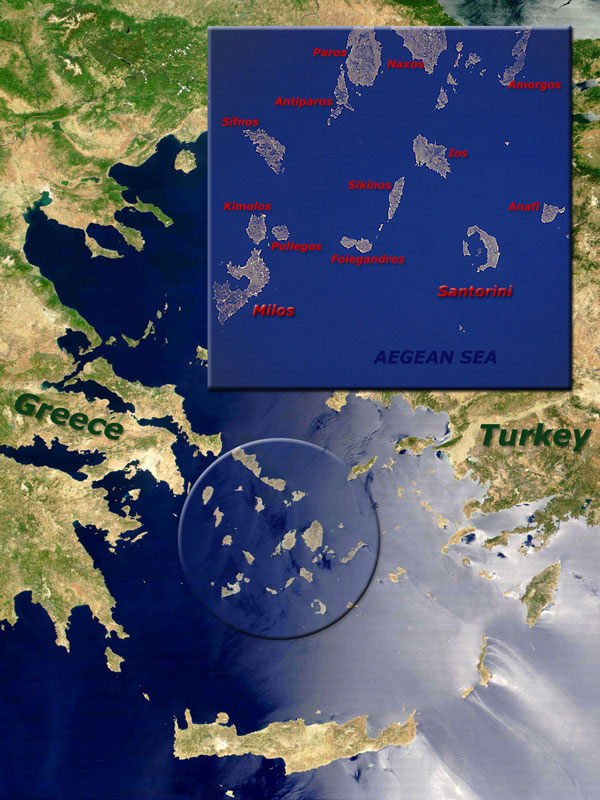The Cycladic Islands in the Aegean Sea, focus area for PHAEDRA 2006. Click image for larger view and image credit.
Project PHAEDRA 2006
June 25 - July 4, 2006
From June 25 to July 4, a Woods Hole Oceanographic Institution and Hellenic Center for Marine Research – led team of engineers, geologists, geochemists, archaeologists, and historians will embark on the Greek research vessel Aegaeo to explore deep sites within Greek national waters. Named for a Greek mythological character, Project PHAEDRA 2006 is the second season of a multi-year Greek-American ocean research partnership. This year the PHAEDRA team is using a combination of deep submergence technologies with integrated technological systems that will collect data to answer questions fundamental to both social science and earth science.
Project PHAEDRA embraces three areas of inquiry: archaeology in deep water, deep submergence technology development, and oceanographic science. Using advanced deep submergence technology, we intend over time to document statistically significant numbers of ancient shipwrecks from various periods in order to reach new insights about human history and pre-history. An interdisciplinary project, PHAEDRA scientists will also investigate geological and geochemical features such as hydrothermal vents, methane seeps and brine pools, fluid flow and seeping through submarine active faults to better understand the processes at work in the deep sea.PHAEDRA’s primary institutional partners are the Hellenic Centre for Marine Research (HCMR) ![]() ; and the Woods Hole Oceanographic Institution (WHOI)
; and the Woods Hole Oceanographic Institution (WHOI) ![]() . Additional partners are the Massachusetts Institute of Technology (MIT)
. Additional partners are the Massachusetts Institute of Technology (MIT) ![]() , the Johns Hopkins University
, the Johns Hopkins University ![]() , University of Michigan, Franklin W. Olin College of Engineering
, University of Michigan, Franklin W. Olin College of Engineering ![]() , and University of Southampton
, and University of Southampton ![]() . Support for this program comes from NOAA OE, the Hellenic Centre for Marine Research, the National Science Foundation, the Thera Foundation, and private sponsors.
. Support for this program comes from NOAA OE, the Hellenic Centre for Marine Research, the National Science Foundation, the Thera Foundation, and private sponsors.
Updates & Logs
Click images or links below for detailed mission logs and updates.
 July 3 The SeaBED AUV and the Thetis work the wreck site together - the first time two such vehicles have conducted simultaneous operations.
July 3 The SeaBED AUV and the Thetis work the wreck site together - the first time two such vehicles have conducted simultaneous operations. July 2 Multibeam sonar systems are used to identfy the depth and shape of the seafloor - and to find shipwrecks.
July 2 Multibeam sonar systems are used to identfy the depth and shape of the seafloor - and to find shipwrecks. July 1 Today we will descend into the bottom of the volcano.
July 1 Today we will descend into the bottom of the volcano. June 30 On the wine-dark sea, how do you figure out where you are? Through the art and science of navigation.
June 30 On the wine-dark sea, how do you figure out where you are? Through the art and science of navigation. June 29 After a warning alarm cancels the day's dive, engineers examine the Thetis for problems.
June 29 After a warning alarm cancels the day's dive, engineers examine the Thetis for problems.  June 28 The submersible descends to the sea bottom and observes active hydrothermal venting.
June 28 The submersible descends to the sea bottom and observes active hydrothermal venting.  June 27 Chemical sensors on board the Thetis submersible allow it to 'sniff' out the presence of hydrogen sulfide and make other discoveries.
June 27 Chemical sensors on board the Thetis submersible allow it to 'sniff' out the presence of hydrogen sulfide and make other discoveries. June 26 In clear indigo waters, Pilot Konstantinos "Kostas" Katsaros takes the Thetis HOV into the depths for the first dive of the expedition.
June 26 In clear indigo waters, Pilot Konstantinos "Kostas" Katsaros takes the Thetis HOV into the depths for the first dive of the expedition. June 25 The past several days have been consumed with getting equipment ready for exploration. Watching an ocean expedition mobilize is always impressive.
June 25 The past several days have been consumed with getting equipment ready for exploration. Watching an ocean expedition mobilize is always impressive.


















